| Oracle® Database SQL Reference 10g Release 1 (10.1) Part Number B10759-01 |
|
|
View PDF |
| Oracle® Database SQL Reference 10g Release 1 (10.1) Part Number B10759-01 |
|
|
View PDF |
Purpose
Use the ALTER TYPE statement to add or drop member attributes or methods. You can change the existing properties (FINAL or INSTANTIABLE) of an object type, and you can modify the scalar attributes of the type.
You can also use this statement to recompile the specification or body of the type or to change the specification of an object type by adding new object member subprogram specifications.
Prerequisites
The object type must be in your own schema and you must have CREATE TYPE or CREATE ANY TYPE system privilege, or you must have ALTER ANY TYPE system privileges.
Syntax
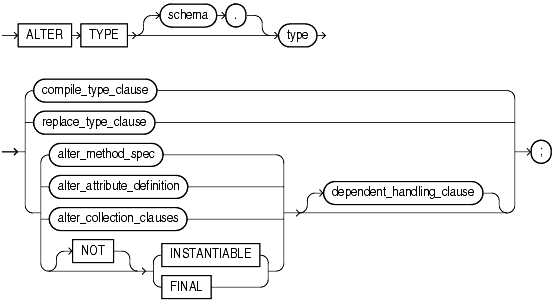
(compile_type_clause ::=, replace_type_clause ::=, alter_method_spec ::=, alter_attribute_definition::=, alter_collection_clauses ::=, dependent_handling_clause ::=)


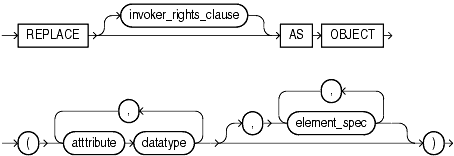


(inheritance_clauses::=, subprogram_spec::=, constructor_spec::=, map_order_function_spec::=, pragma_clause ::=)
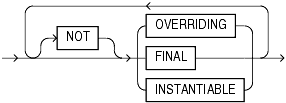

(procedure_spec::=, function_spec::=)


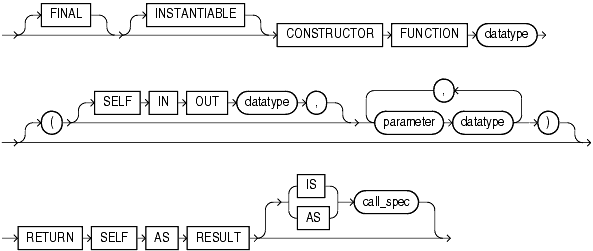



(map_order_function_spec::=, subprogram_spec::=)
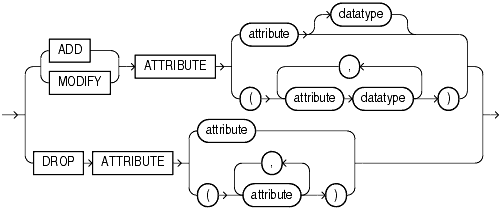



Semantics
Specify the schema that contains the type. If you omit schema, then Oracle Database assumes the type is in your current schema.
Specify the name of an object type, a nested table type, or a varray type.
Specify COMPILE to compile the object type specification and body. This is the default if neither SPECIFICATION nor BODY is specified.
During recompilation, Oracle Database drops all persistent compiler switch settings, retrieves them again from the session, and stores them at the end of compilation. To avoid this process, specify the REUSE SETTINGS clause.
If recompiling the type results in compilation errors, then the database returns an error and the type remains invalid. You can see the associated compiler error messages with the SQL*Plus command SHOW ERRORS.
Specify DEBUG to instruct the PL/SQL compiler to generate and store the code for use by the PL/SQL debugger. Specifying this clause has the same effect as specifying PLSQL_DEBUG = TRUE in the compiler_parameters_clause.
Specify SPECIFICATION to compile only the object type specification.
Specify BODY to compile only the object type body.
Use this clause to specify a value for one of the PL/SQL compiler parameters. The parameters you can specify in this clause are PLSQL_OPTIMIZE_LEVEL, PLSQL_CODE_TYPE, PLSQL_DEBUG, PLSQL_WARNINGS, and NLS_LENGTH_SEMANTICS.
You can specify each parameter only once in each statement. Each setting is valid only for the current library unit being compiled and does not affect other compilations in this session or system. To affect the entire session or system, you must set a value for the parameter using the ALTER SESSION or ALTER SYSTEM statement.
If you omit any parameter from this clause and you specify REUSE SETTINGS, then if a value was specified for the parameter in an earlier compilation of this library unit, Oracle Database uses that earlier value. If you omit any parameter and either you do not specify REUSE SETTINGS or no value has been specified for the parameter in an earlier compilation, then the database obtains the value for that parameter from the session environment.
You cannot set a value for the PLSQL_DEBUG parameter if you also specify DEBUG, because both clauses set the PLSQL_DEBUG parameter, and you can specify a value for each parameter only once.
Specify REUSE SETTINGS to prevent Oracle from dropping and reacquiring compiler switch settings. With this clause, Oracle preserves the existing settings and uses them for the recompilation of any parameters for which values are not specified elsewhere in this statement.
For backward compatibility, Oracle Database sets the persistently stored value of the PLSQL_COMPILER_FLAGS initialization parameter to reflect the values of the PLSQL_CODE_TYPE and PLSQL_DEBUG parameters that result from this statement.
The REPLACE clause lets you add new member subprogram specifications. This clause is valid only for object types, not for nested tables or varrays.
Specify an object attribute name. Attributes are data items with a name and a type specifier that form the structure of the object.
Specify the elements of the redefined object.
The inheritance_clauses have the same semantics in CREATE TYPE and ALTER TYPE statements. Please refer to inheritance_clauses in the documentation on CREATE TYPE.
The MEMBER and STATIC clauses let you specify for the object type a function or procedure subprogram which is referenced as an attribute.
You must specify a corresponding method body in the object type body for each procedure or function specification.
|
See Also:
|
Enter the specification of a procedure subprogram.
Enter the specification of a function subprogram.
The pragma_clause is a compiler directive that denies member functions read/write access to database tables, packaged variables, or both, and thereby helps to avoid side effects.
Oracle recommends that you avoid using this clause unless you must do so for backward compatibility of your applications. This clause has been deprecated. Oracle Database now runs purity checks at run time. If you must use this clause for backward compatibility of your applications, you can find its description in pragma_clause (under CREATE TYPE).
The pragma_clause is not valid when dropping a method.
You can declare either one MAP method or one ORDER method, regardless how many MEMBER or STATIC methods you declare. However, a subtype can override a MAP method if the supertype defines a NOT FINAL MAP method. If you declare either method, then you can compare object instances in SQL.
If you do not declare either method, then you can compare object instances only for equality or inequality. Instances of the same type definition are equal only if each pair of their corresponding attributes is equal. No comparison method needs to be specified to determine the equality of two object types.
For MAP, specify a member function (MAP method) that returns the relative position of a given instance in the ordering of all instances of the object. A map method is called implicitly and induces an ordering of object instances by mapping them to values of a predefined scalar type. Oracle Database uses the ordering for comparison conditions and ORDER BY clauses.
If type will be referenced in queries involving sorts (through ORDER BY, GROUP BY, DISTINCT, or UNION clauses) or joins, and you want those queries to be parallelized, then you must specify a MAP member function.
If the argument to the MAP method is null, then the MAP method returns null and the method is not invoked.
An object specification can contain only one MAP method, which must be a function. The result type must be a predefined SQL scalar type, and the MAP function can have no arguments other than the implicit SELF argument.
A subtype cannot define a new MAP method. However, it can override an inherited MAP method.
For ORDER, specify a member function (ORDER method) that takes an instance of an object as an explicit argument and the implicit SELF argument and returns either a negative, zero, or positive integer. The negative, zero, or positive value indicates that the implicit SELF argument is less than, equal to, or greater than the explicit argument.
If either argument to the ORDER method is null, then the ORDER method returns null and the method is not invoked.
When instances of the same object type definition are compared in an ORDER BY clause, the ORDER method function is invoked.
An object specification can contain only one ORDER method, which must be a function having the return type NUMBER.
A subtype cannot define an ORDER method, nor can it override an inherited ORDER method.
The invoker_rights_clause lets you specify whether the member functions and procedures of the object type execute with the privileges and in the schema of the user who owns the object type or with the privileges and in the schema of CURRENT_USER. This specification applies to the corresponding type body as well.
This clause also determines how Oracle Database resolves external names in queries, DML operations, and dynamic SQL statements in the member functions and procedures of the type.
You can specify this clause only for an object type, not for a nested table or varray.
Specify CURRENT_USER if you want the member functions and procedures of the object type to execute with the privileges of CURRENT_USER. This clause creates an invoker-rights type.
You must specify this clause to maintain invoker-rights status for the type if you created it with this status. Otherwise the status will revert to definer rights.
This clause also specifies that external names in queries, DML operations, and dynamic SQL statements resolve in the schema of CURRENT_USER. External names in all other statements resolve in the schema in which the type resides.
Specify DEFINER if you want the member functions and procedures of the object type to execute with the privileges of the owner of the schema in which the functions and procedures reside, and that external names resolve in the schema where the member functions and procedures reside. This is the default.
|
See Also:
|
The alter_method_spec lets you add a method to or drop a method from type. Oracle Database disables any function-based indexes that depend on the type.
In one ALTER TYPE statement you can add or drop multiple methods, but you can reference each method only once.
When you add a method, its name must not conflict with any existing attributes in its type hierarchy.
When you drop a method, Oracle Database removes the method from the target type.
You cannot drop from a subtype a method inherited from its supertype. Instead you must drop the method from the supertype.
The MEMBER and STATIC clauses let you add a procedure subprogram to or drop it from the object type.
You cannot define a STATIC method on a subtype that redefines a MEMBER method in its supertype, or vice versa. Please refer to the description of the subprogram_spec in CREATE TYPE for more information.
If you declare either a MAP or ORDER method, then you can compare object instances in SQL.
You cannot add an ORDER method to a subtype. Please refer to the description of constructor_spec in CREATE TYPE for more information.
The alter_attribute_definition clause lets you add, drop, or modify an attribute of an object type. In one ALTER TYPE statement, you can add, drop, or modify multiple member attributes or methods, but you can reference each attribute or method only once.
The name of the new attribute must not conflict with existing attributes or methods in the type hierarchy. Oracle Database adds the new attribute to the end of the locally defined attribute list.
If you add the attribute to a supertype, then it is inherited by all of its subtypes. In subtypes, inherited attributes always precede declared attributes. Therefore, you may need to update the mappings of the implicitly altered subtypes after adding an attribute to a supertype.
When you drop an attribute from a type, Oracle Database drops the column corresponding to the dropped attribute as well as any indexes, statistics, and constraints referencing the dropped attribute.
You need not specify the datatype of the attribute you are dropping.
You cannot drop an attribute inherited from a supertype. Instead you must drop the attribute from the supertype.
You cannot drop an attribute that is part of a partitioning, subpartitioning, or cluster key.
You cannot drop an attribute of a primary-key-based object identifier of an object table or a primary key of an index-organized table.
You cannot drop all of the attributes of a root type. Instead you must drop the type. However, you can drop all of the locally declared attributes of a subtype.
This clause lets you modify the datatype of an existing scalar attribute. For example, you can increase the length of a VARCHAR2 or RAW attribute, or you can increase the precision or scale of a numeric attribute.
You cannot expand the size of an attribute referenced in a function-based index, domain index, or cluster key.
Use this clause to indicate whether any further subtypes can be created for this type:
Specify FINAL if no further subtypes can be created for this type.
Specify NOT FINAL if further subtypes can be created under this type.
If you change the property between FINAL and NOT FINAL, then you must specify the CASCADE clause of the dependent_handling_clause to convert data in dependent columns and tables.
If you change a type from NOT FINAL to FINAL, then you must specify CASCADE [INCLUDING TABLE DATA]. You cannot defer data conversion with CASCADE NOT INCLUDING TABLE DATA.
If you change a type from FINAL to NOT FINAL:
Specify CASCADE INCLUDING TABLE DATA if you want to create new substitutable tables and columns of that type, but you are not concerned about the substitutability of the existing dependent tables and columns. Oracle Database marks all existing dependent columns and tables NOT SUBSTITUTABLE AT ALL LEVELS, so you cannot insert the new subtype instances of the altered type into these existing columns and tables.
Specify CASCADE CONVERT TO SUBSTITUTABLE if you want to create new substitutable tables and columns of the type and also store new subtype instances of the altered type in existing dependent tables and columns. Oracle Database marks all existing dependent columns and tables SUBSTITUTABLE AT ALL LEVELS except those that are explicitly marked NOT SUBSTITUTABLE AT ALL LEVELS.
|
See Also: Oracle Database Application Developer's Guide - Object-Relational Features for a full discussion of object type evolution |
You cannot change a user-defined type from NOT FINAL to FINAL if the type has any subtypes.
Use this clause to indicate whether any object instances of this type can be constructed:
Specify INSTANTIABLE if object instances of this type can be constructed.
Specify NOT INSTANTIABLE if no constructor (default or user-defined) exists for this object type. You must specify these keywords for any type with noninstantiable methods and for any type that has no attributes (either inherited or specified in this statement).
You cannot change a user-defined type from INSTANTIABLE to NOT INSTANTIABLE if the type has any table dependents.
These clauses are valid only for collection types.
This clause lets you increase the number of elements in a varray. It is not valid for nested tables. Specify an integer greater than the current maximum number of elements in the varray.
This clause lets you increase the precision, size, or length of a scalar datatype of a varray or nested table. This clause is not valid for collections of object types.
For a collection of NUMBER, you can increase the precision or scale.
For a collection of RAW, you can increase the maximum size.
For a collection of VARCHAR2 or NVARCHAR2, you can increase the maximum length.
The dependent_handling_clause lets you instruct Oracle Database how to handle objects that are dependent on the modified type. If you omit this clause, then the ALTER TYPE statement will abort if type has any dependent type or table.
Specify INVALIDATE to invalidate all dependent objects without any checking mechanism.
|
Note: Oracle Database does not validate the type change, so you should use this clause with caution. For example, if you drop an attribute that is a partitioning or cluster key, then you will be unable to write to the table. |
Specify the CASCADE clause if you want to propagate the type change to dependent types and tables. Oracle Database aborts the statement if any errors are found in the dependent types or tables unless you also specify FORCE.
If you change the property of the type between FINAL and NOT FINAL, you must specify this clause to convert data in dependent columns and tables. Please refer to [NOT] FINAL.
Specify INCLUDING TABLE DATA to convert data stored in all user-defined columns to the most recent version of the column type. This is the default.
|
Note: You must specify this clause if your column data is in Oracle8 release 8.0 image format. This clause is also required if you are changing the type property betweenFINAL and NOT FINAL |
For each attribute added to the column type, Oracle Database adds a new attribute to the data and initializes it to null.
For each attribute dropped from the referenced type, Oracle Database removes the corresponding attribute data from each row in the table.
If you specify INCLUDING TABLE DATA, then all of the tablespaces containing the table data must be in read/write mode.
If you specify NOT INCLUDING TABLE DATA, then the database upgrades the metadata of the column to reflect the changes to the type but does not scan the dependent column and update the data as part of this ALTER TYPE statement. However, the dependent column data remains accessible, and the results of subsequent queries of the data will reflect the type modifications.
|
See Also: Oracle Database Application Developer's Guide - Object-Relational Features for more information on the implications of not including table data when modifying type attribute |
Specify this clause if you are changing the type from FINAL to NOT FINAL and you want to create new substitutable tables and columns of the type and also store new subtype instances of the altered type in existing dependent tables and columns. See [NOT] FINAL for more information.
Specify FORCE if you want Oracle Database to ignore the errors from dependent tables and indexes and log all errors in the specified exception table. The exception table must already have been created by executing the DBMS_UTILITY.CREATE_ALTER_TYPE_ERROR_TABLE procedure.
Examples
The following example uses the data_typ object type, which was created in "Object Type Examples". A method is added to data_typ and its type body is modified to correspond. The date formats are consistent with the order_date column of the oe.orders sample table:
ALTER TYPE data_typ
ADD MEMBER FUNCTION qtr(der_qtr DATE)
RETURN CHAR CASCADE;
CREATE OR REPLACE TYPE BODY data_typ IS
MEMBER FUNCTION prod (invent NUMBER) RETURN NUMBER IS
BEGIN
RETURN (year + invent);
END;
MEMBER FUNCTION qtr(der_qtr DATE) RETURN CHAR IS
BEGIN
IF (der_qtr < TO_DATE('01-APR', 'DD-MON')) THEN
RETURN 'FIRST';
ELSIF (der_qtr < TO_DATE('01-JUL', 'DD-MON')) THEN
RETURN 'SECOND';
ELSIF (der_qtr < TO_DATE('01-OCT', 'DD-MON')) THEN
RETURN 'THIRD';
ELSE
RETURN 'FOURTH';
END IF;
END;
END;
/
The following example adds the phone_list_typ varray from the sample oe schema to the cust_address_typ object column of the customers table:
ALTER TYPE cust_address_typ ADD ATTRIBUTE (phone phone_list_typ) CASCADE;
The following example increases the maximum number of elements in the varray phone_list_typ:
ALTER TYPE phone_list_typ MODIFY LIMIT 1000 CASCADE;
The following example increases the length of the varray element type phone_list_typ:
ALTER TYPE phone_list_typ MODIFY ELEMENT TYPE VARCHAR(64) CASCADE;
The following example recompiles type customer_address_typ:
ALTER TYPE customer_address_typ COMPILE;
The following example compiles the type specification of link2.
CREATE TYPE link1 AS OBJECT
(a NUMBER);
/
CREATE TYPE link2 AS OBJECT
(a NUMBER,
b link1,
MEMBER FUNCTION p(c1 NUMBER) RETURN NUMBER);
/
CREATE TYPE BODY link2 AS
MEMBER FUNCTION p(c1 NUMBER) RETURN NUMBER IS
BEGIN
dbms_output.put_line(c1);
RETURN c1;
END;
END;
/
In the following example, both the specification and body of link2 are invalidated because link1, which is an attribute of link2, is altered.
ALTER TYPE link1 ADD ATTRIBUTE (b NUMBER) INVALIDATE;
You must recompile the type by recompiling the specification and body in separate statements:
ALTER TYPE link2 COMPILE SPECIFICATION;
ALTER TYPE link2 COMPILE BODY;
Alternatively, you can compile both specification and body at the same time:
ALTER TYPE link2 COMPILE;